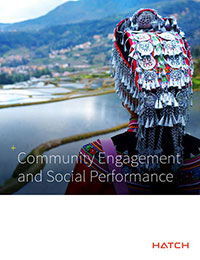Challenge
Across the metals, energy, and infrastructure sectors, stakeholders are becoming more ecologically aware. Communities and governments are demanding higher environmental standards. Global expansion of the extractive and energy sectors, coupled with the consolidation of ownership and assets, has made development projects more visible. This has triggered growing interest, demands, and assertiveness by host governments, communities, investors, and civil society organizations, especially when the environment is at risk.
When development comes to their door, local communities and Indigenous Peoples increasingly expect industry to engage in meaningful dialogue, and for the planning process to be open, inclusive, and participatory.
Changes to the climate are already visible, and the world is recognizing the urgency of curbing emissions to avoid the dangerous effects of climate change. Sustained and universal efforts in all sectors of the economy must be made to slow down and ultimately stop climate change before irreversible damage is done.
Capabilities
Environmental permitting and regulatory compliance
Failure to develop an environmental regulatory strategy can cause costly project delays. Preparing an effective permitting strategy involves knowing both the relevant regulations and technical aspects of a project. We're experienced and knowledgeable with respect to permitting and regulatory compliance in many jurisdictions, and have consistently shown our ability to meet your regulatory and stakeholder expectations.
Environmental and social-impact assessment and management
Many projects, particularly in heavy-industry sectors, are subject to environmental and social-impact assessments and management processes. Requirements vary across jurisdictions and projects, but are based on a common framework. We provide an assessment-and-management approach that integrates environmental, community, and social matters, giving you the ability to cost-effectively manage issues throughout project development.
Sustainable strategies and programs
Profitable and innovative solutions are often found if sustainable-development principles and strategies are integrated early in a project’s life cycle and then carried throughout its phases. Linking sustainability objectives to development outcomes supports strategic decision-making, especially for long-term projects that face regulatory uncertainty.
Climate change
If we're going to mitigate the most severe climate-change impacts, we'll need immediate and sustained actions to drive down greenhouse gas emissions and keep them below a critical threshold. It will require transformative change across all sectors of the economy, using innovative technologies and binding commitments at an international level. Simultaneously, programs that enhance climate resilience, especially in vulnerable regions, are essential for adapting to a changing climate.


